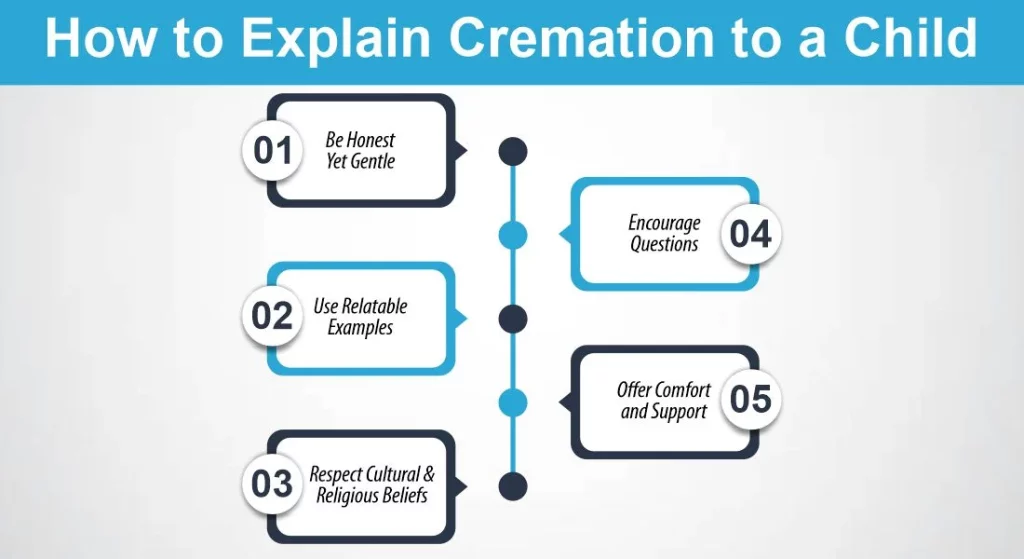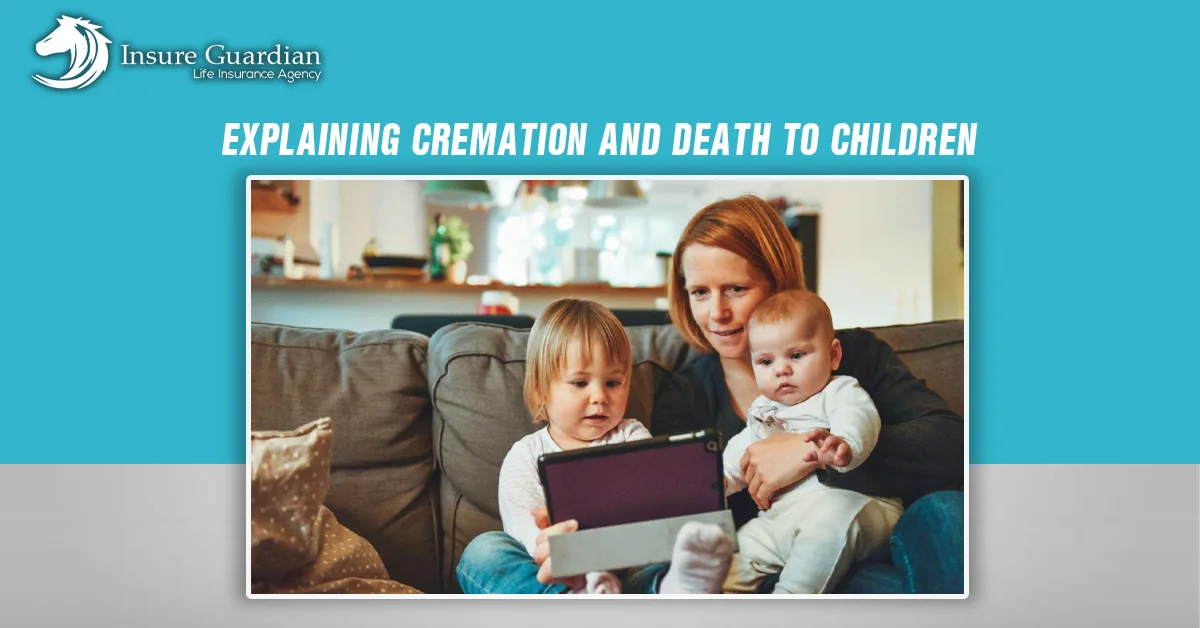Losing a loved one is a natural part of life, but explaining it to a child can be one of the most challenging and heart-wrenching conversations a parent or caregiver faces. When it comes to discussing cremation or death, parents often find themselves navigating uncharted emotional territories while seeking ways to comfort and inform their little ones.
How do you explain such complex concepts to a young mind in a gentle, understanding way? In this guide, we’ll delve into how to broach the subject of cremation with a child, using simple language and relatable examples.
From discussing the cycle of life to providing reassurance and coping mechanisms, we’ll explore the strategies that can help you support your child through this delicate time. Understanding how to approach this conversation with sensitivity can assist in providing comfort and guidance as your child processes the concept of loss and farewell rituals.

How to Explain Cremation to a Child
Explaining cremation to a young child necessitates a delicate balance between honesty and age-appropriate information. It’s crucial to create a safe space where the child feels comfortable expressing their emotions and asking questions.
Here are some steps and suggestions to guide you through this conversation:
1- Be Honest Yet Gentle
Start the conversation by acknowledging your child’s emotions. Use simple language to explain that cremation is a respectful way of saying goodbye to someone who has passed away. Assure them that it’s a choice some people make after death, and it involves transforming the body into ashes. Reiterate that it’s okay to feel sad, and this process is a way to honor the person’s memory. Emphasize that just like how a caterpillar turns into a butterfly, cremation transforms the body into something new.
2- Use Relatable Exampleska
Make the concept relatable by drawing comparisons to natural processes. For instance, you might compare cremation to how a flower wilts and becomes part of the earth, becoming something new. Analogies like these can help children understand that cremation is a respectful way for the body to return to nature, just like how everything in nature changes and evolves.
3- Respect Cultural and Religious Beliefs
Explain that different cultures have various ways of saying goodbye to loved ones after they die. Mention that some cultures have ceremonies or rituals associated with cremation as a way to honor the person’s life and memory. Share how your family or community approaches these traditions and how they show respect and love for the person who has passed away.
4- Encourage Questions
Create a safe space for your child to ask questions. Let them know that it’s okay to feel curious or confused and that you’re there to provide answers. Reassure them that their feelings are normal and valid. Encouraging questions can help ease their worries and allow for an open conversation about a sensitive topic.
5- Offer Comfort and Support
Reassure your child that it’s okay to feel sad or miss the person who passed away. Encourage them to talk about their feelings, share memories, or create something special in remembrance. Offer hugs, comfort, and support during this difficult time, reminding them that they are loved and not alone in their emotions.
Explaining Death to a Child
Explaining death to a child is a delicate and challenging task that requires sensitivity and understanding. When discussing this profound concept with a young mind, it’s essential to use simple language and provide reassurance while acknowledging their emotions. Here are some steps to help you approach the conversation:
1- Use Age-Appropriate Language
Tailor your explanation based on the child’s age and maturity level. Use clear and straightforward language to convey the idea that death means the body stops working and doesn’t feel anything anymore. Avoid using confusing euphemisms that might cause misunderstanding.
2- Discuss Feelings and Emotions
Emphasize that it’s natural to feel sad or upset when someone dies. Encourage the child to express their emotions and reassure them that it’s okay to cry or feel different emotions at different times.
3- Discuss the Cycle of Life
Explain that life has a cycle – people are born, they live, and eventually, everyone passes away. Emphasize that memories of the person will remain, even though they are no longer physically here.
4- Provide Reassurance
Reassure the child that they are safe and cared for. Let them know that it’s normal to have questions and that you are there to answer them and support them through their feelings of grief.
5- Introducing the Concept of Death
Begin by gently introducing the idea of death. Use simple language to explain that death means the body stops working, and the person or animal doesn’t feel anything anymore. Emphasize that it’s a natural part of life’s cycle and happens to everyone eventually.
6- Addressing Common Questions
Anticipate and address the questions your child might have about death. Encourage them to ask anything that comes to mind, and answer their queries with honesty and patience. Be prepared for questions about what happens after someone dies.
7- Exploring Emotions and Coping
Discuss the range of emotions the child might feel when someone dies – sadness, confusion, anger – and reassure them that it’s okay to feel these emotions. Offer coping mechanisms such as talking about memories or doing activities that help them express their feelings.
8- Honoring and Remembering
Talk about different ways people honor and remember those who have passed away. Discuss rituals, ceremonies, or traditions that your family or community might practice to honor the memory of the person or pet.
Conclusion
Explaining cremation and death to a child is a sensitive and challenging task. It’s essential to approach this conversation with empathy, honesty, and patience, providing a supportive environment for the child to navigate their emotions and understanding of this natural part of life.
Remember, every child processes loss differently, so continue offering your love, support, and guidance as they navigate through this difficult time. By having open conversations and offering comfort, we can help children comprehend and cope with the concept of cremation and death in a healthy and understanding manner.
FAQs on Explaining Cremation and Death to Children:
1- Should I use euphemisms or metaphors when explaining cremation or death to a child?
It’s generally better to use clear and direct language when explaining such concepts to children. Using euphemisms might lead to confusion or misunderstanding. Simple and honest explanations tend to be more helpful.
2- How can I help a child cope with the sadness of losing a loved one after discussing cremation or death?
Encourage the child to express their feelings. Offer support by validating their emotions and providing comforting activities like drawing, sharing memories, or creating a special tribute. Open communication and reassurance are key in helping them cope.
3- Are there any cultural differences in explaining cremation or death to children?
Absolutely. Different cultures have varying beliefs and practices regarding death and cremation. It’s important to discuss these differences, emphasizing that various traditions exist, each with its way of honoring and remembering those who have passed away.
4- How do I handle a child’s curiosity about what happens after someone dies?
Answer their questions honestly and age-appropriately. You can explain different beliefs about what happens after death in a gentle manner, considering the child’s age, and emphasizing the importance of respecting diverse beliefs.
5- Can a child attend a cremation or funeral?
It depends on the child’s age, maturity, and the family’s preferences. Some families may choose to involve children in these ceremonies to help them understand and say goodbye, while others might decide it’s more suitable for the child to participate indirectly or in a different way.
6- How do I continue supporting a child after discussing cremation or death?
Be open to ongoing conversations. Ensure the child knows you’re available to talk whenever they have questions or need comfort. Engage in activities that allow them to express emotions and memories, keeping the memory of the loved one alive in a positive way.

Meet Haider, our expert Life Insurance Content Writer and Editor. With a passion for clarity, he simplify the complex world of life insurance, delivering informative, polished content tailored to our clients’ needs.







